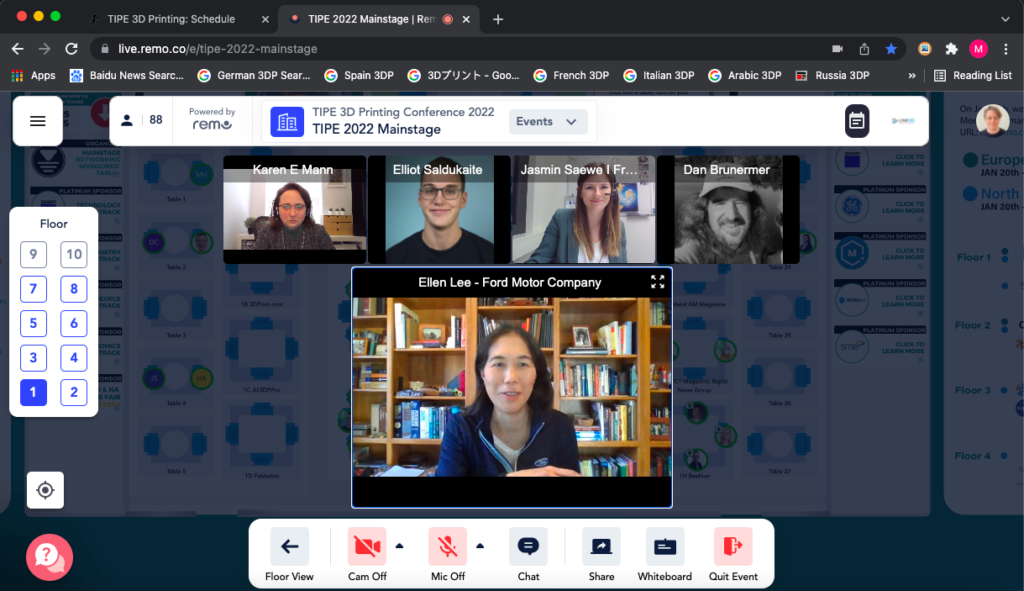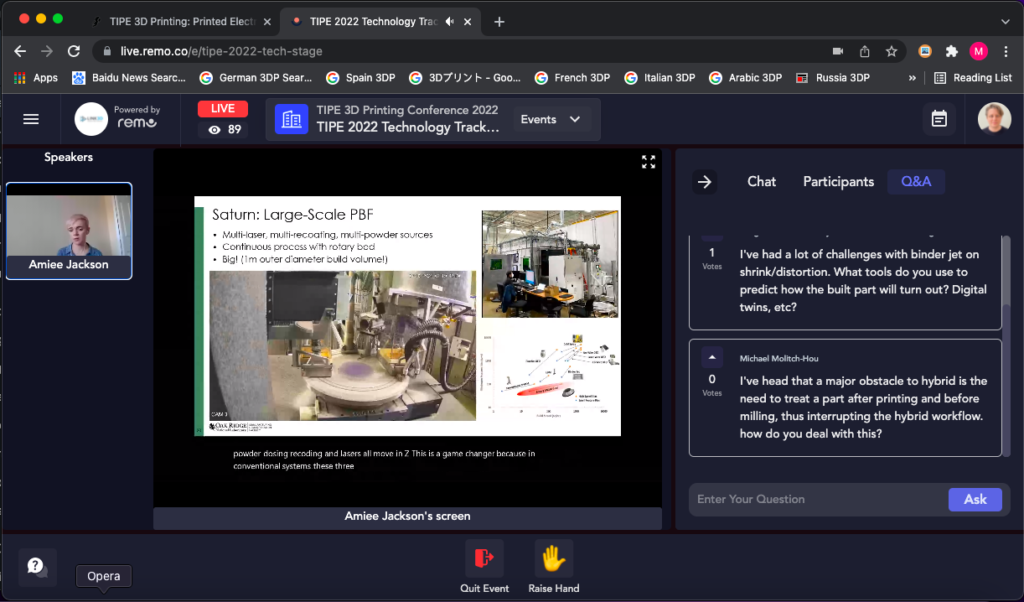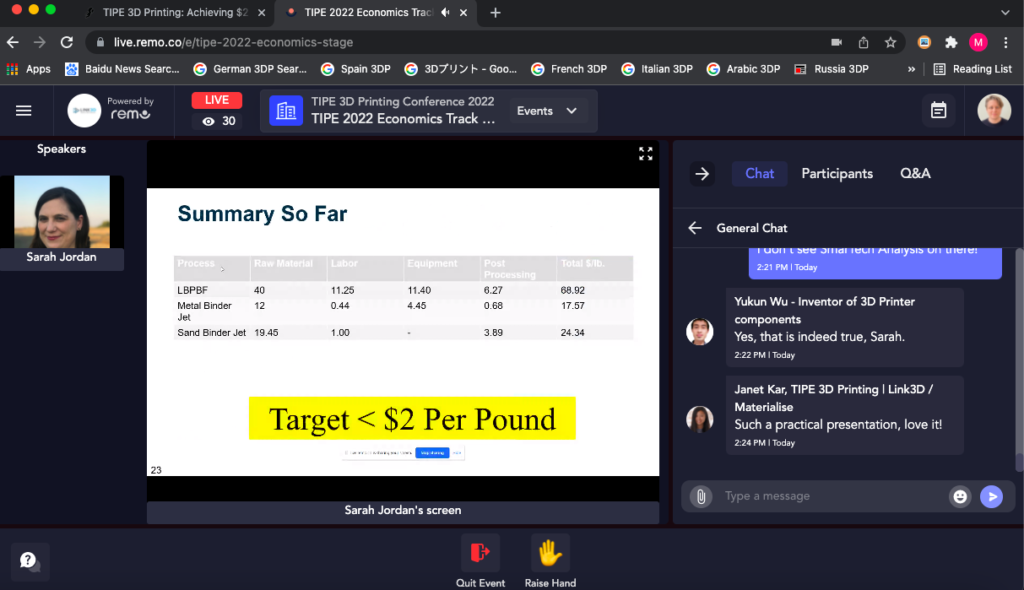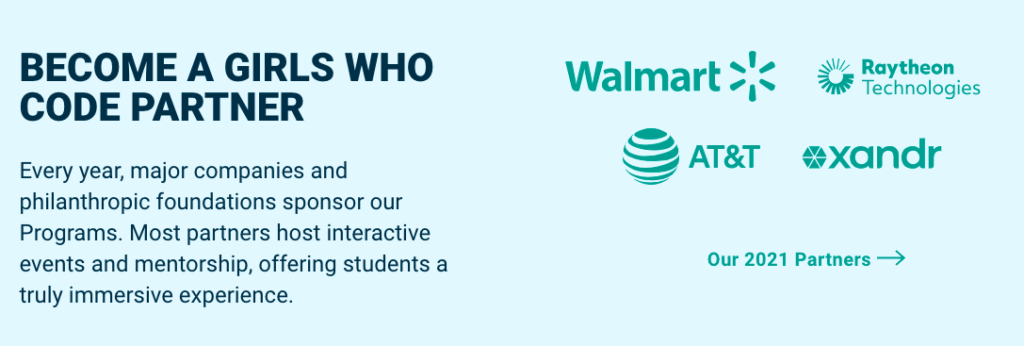Women in 3D Printing (Wi3DP) has pulled off another virtual event show coup. After an immensely successful inaugural event in 2021, the non-profit has hosted an even bigger 2022 event. And while Technology, Industry, People, and Economics (TIPE) represent the tracks that make up the event’s namesake, TIPE 2022 really was representative of those ideas. However, it was the “people” component that really set the show apart from every other industry event I’ve attended.
This was demonstrated in a variety of ways, including the leadership itself. As new Wi3DP president Kristin Mulherin noted in her opening of the event, last year’s attendees demanded more networking time and this year, there was plenty. And this was a major component of the event.
The event had eight “floors” of tables per vertical. This meant plenty of opportunities to meet people virtually, as well as many empty tables because it was just impossible for the remote population to fill up that many locations. This also made it a bit confusing when jumping from one vertical to the next to look for attendees. However, the benefits of the format definitely outweighed what was a temporarily confusing setup.
As someone who is generally more introverted in person, the ability to connect on the web opened up many more chances to speak to others or simply listen in on engaging conversations. For instance, there were many times when entire tables, such as those from Trumpf and GE Additive, were filled to a maximum capacity of eight people. With attendees coming from such diverse backgrounds, whether a PhD researcher from Germany or an entrepreneur from South Africa, one could easily sit in and learn a lot from the engaging conversations.

An example of a conversation around a virtual table.
Whereas I would have been a bit too shy to engage with Ellen Lee, Technical Leader Additive Manufacturing Research at Ford Motor Company, in person, I was able to eavesdrop on a conversation she had with Jasmin Saewe, head of the Laser Powder Bed Fusion Department at Fraunhofer ILT, and Dan Brunermer, one of the developers of metal binder jetting at ExOne. Otherwise, I wouldn’t have necessarily gotten to hear about the synergies across those three areas, with Brunermer describing how he is developing a small, flexible R&D system for binder jet that both Saewe and Lee believed to be an exciting development for those in a lab environment, though neither work directly with the technology.

A presentation on Oak Ridge National Laboratory’s hybrid manufacturing research. This, along with other projects I learned about from TIPE 2022, will be discussed in greater detail later on.
While at another table, I overheard people like Caterina Pampolari, Product Manager at Magnitude Innovations, share what it’s like to be a part of a small business and finding the right number of team members (it turns out six is the perfect size). Malika Khodja, a 3D printing consultant based in South Africa and chair of Wi3DP’s Africa committee, and Tuan TranPham, Chief Revenue Officer at Azul3D, discussed the potential for the 3D printing industry on the continent. TranPham highlighted South Africa’s supply of precious metals and titanium. Khodja said she is advocating for local production of metal 3D printing powders, with businesses using atomizers to make materials rather than export their rich resource supply to other nations with which to profit.
Of course, to fuel these lively discussions were the equally engaging talks. There were the three major keynotes, which obviously had a broad appeal given that Anouk Wipprecht and Julia Körner’s showcased their amazing 3D printing design work. Reshma Saujani, CEO of Marshall Plan for Moms and founder of Girls Who Code, was able to shed light on the inequity facing women and moms, in particular, in the workplace and, more importantly, what there is to do about it.

Outside of the keynotes, there were a wide range of topics, from those of a highly technical nature to socially driven talks. As an example, Sarah Jordan, CEO of Skuld LLC, broke down to the dollar the cost of various metal production technologies—including laser powder bed fusion, metal binder jetting, and sand casting—and comparing them to her own firm’s process, additive manufacturing evaporative casting (AMEC). Using low-cost printers and materials, Skuld 3D performs a form of casting using 3D printed molds, which Jordan claimed resulted in much lower costs per part compared to the aforementioned metal production techniques.
In contrast, Lisa Block, Director of Global Sales and Marketing for Hybrid Manufacturing, spoke about something that anyone, in 3D printing or otherwise, could relate to: disagreement. Block took what is typically a concept that might be challenging for many people and framed it in a positive light, saying, “A good disagreement can be the best thing that ever happened to you it can refine you in ways that agreement never can.” Block argued that, for those of us that may be hesitant to share our opinions, particularly when they contrast with the consensus, it can be beneficial to everyone as a whole to express ourselves. This, of course, was particularly relevant for voices that may be silenced, such people from oppressed groups.
At times, the talk took on the tone of a self-help lecture, particularly when Block concluded:
“You don’t get to your greatest good by settling. Disagree. Tell yourself, ‘I am more than this. My life is worth more than this. I have settled for whatever the world decides to give me and the world deserves the gift of my opinion.’ I promise you: something beautiful happens. Suddenly, you trust yourself more and, just as an after effect of your willingness to be protective and have productive conflict with another person, you suddenly find yourself taking more chances. You find yourself loving a little harder. You find yourself looking a little deeper, creating a little better. You find yourself—well, you find yourself. So, by all means, disagree.”
These were just two samples of many presentations that wowed and inspired audiences. And during those talks, attendees often found lively conversation in the chat box, which also featured an accessible means of interacting with speakers via Q&A. In a panel on work-life balance, four women spoke about tackling this difficult, but very real issue in employment. This was especially challenging for working parents in the U.S., where the federal and state governments have failed to provide proper paternity leave or caregiver options. On the panel and in the chat, parents expressed anger and sadness with the poor treatment of families in the U.S.
This tied directly into what Saujani discussed in her talk on gender and parenthood in the fields of science, technology, engineering and mathematics (STEM). Her advocacy group, Marshall Plan for Moms (not to be confused with the Marshall Plan that gave the U.S. economic supremacy post-World War Two), aims to address the fact that women are leaving and/or suffering within the U.S. workforce after tireless decades working to establish a place there.
Noting that 2.3 million women left the job market in 2021 and women of color are leaving at twice the rate of white women, the organization attempts to raise awareness and educate people about topics like paid paternity leave and affordable childcare using a variety of marketing initiatives. Most concretely, Marshall Plan for Moms legislation was introduced into the U.S. House of Representatives and Senate.
When asked “Should we rely on government policies to change the workplace for working moms or is a push on the private sector what’s needed?”, Saujani suggested that we can’t rely on the government, a sentiment I heard echoed in the panel on work-life balance, as evidenced by the fact that the bureaucracy had so mismanaged the COVID-19 response:
“You can’t rely on the government. I mean, the fact that, in the middle of the pandemic—where we’ve pushed millions of women out of the workforce and you have daycare centers shut down—we still can’t pass Build Back Better. It’s shameful. So much of our work at Marshall Plan for Moms is turning to the private sector and so much of my book, Pay Up, is about a playbook for the private sector,” Saujani said. “Even if you think about health care, the private sector offered health care before the government did. The private sector started offering paid leave before the government did. So, I think the private sector can actually make movement on childcare before the government does because part of it is having this cultural shift that caretaking is not your private problem.”
Saujani made some excellent points and it is abundantly clear that the U.S. government from the federal level down is hindered by severe corruption, incompetence, political infighting and sheer unwillingness. However, I was wary of the idea of then turning to corporations to pick up the slack, due to their own corruption, a concern I posted in the presentation’s chat box. Before signing off, the Girls Who Code founder addressed my comment:
“I do think that government should ultimately be the one that is providing opportunities for everybody, but in the absence of government leadership, we can’t do nothing,” she said. “When I started Girls Who Code, less than one out of ten high schools offered computer science and I could not get a grant from the government or a foundation to save my life, but you know who was willing to fund me? Companies. And they’re the reason why I’ve taught more girls than any public school district in the country. But when Google or Uber and people do the wrong thing, we stand up. Nobody owns us. So, I think that there’s an ability to hold the private sector as partners and accountable at the same time in the absence of leadership from the government. We don’t have a choice. this is a really good point.”
Again, she raised good points, but I think that Saujani and I may have different ideas about how to address an inadequate government and social safety net. There’s no doubt the impact that her work has made, but it is difficult to reconcile the mission of closing the STEM gender gap and partnering with a company like Raytheon. The weapons manufacturer both aided in creating a humanitarian crisis in Yemen and also teamed with Girl Scouts of America to push girls “to explore computer science careers and realize their potential to help make the world a better, safer place.” By using pro-female groups, the military giant is able to wash over the disproportionately negative impact that war has on women and children.

Image courtesy of Girls Who Code website.
Of course, it’s difficult for me to offer critical analysis as someone who has not helped get half a million girls learning to code, as Saujani has. However, it was hard not to pick up on a broader issue within not TIPE itself, but tech-related conferences in general. As a beneficiary of the Global North, I can’t help but notice how much industry and technology serves the wealthier members of society at the expense of the world’s poorer residents and the health of the planet as a whole.
Oxfam pointed out that the richest 10 percent of the population are responsible for half of the world’s carbon emissions. In contrast, the poorest half of the population account for just 10 percent. And this carbon inequality is only increasing. Industry as a global phenomenon is contributing to this terminal state of affairs because, as we increase production (additive or otherwise. See: Jevons Paradox), we increase carbon emissions and environmental destruction, while robbing the Global South of its resources and livelihood.
So, while it may be necessary to turn to a company like Raytheon to fund coding initiatives or to ask Microsoft and Google to provide paid paternity leave, my mind turns to more radical alternatives that may not hold up well in the confines of an industry-related forum. Not only because so many of the stakeholders are from industry, but because there are employers present. And if we can’t speak openly about systemic issues in front of employers, it speaks to the limits of turning to companies for help when it comes to social welfare.
At my previous job, I was a U.S.-based contract worker for a Canadian business. Despite the fact that I worked full time and had a semi-managerial role, I was paid on a per article basis with no fixed salary, let alone benefits. When I and two other contract employees tried to approach my immediate supervisor to see if we should talk to the CEO about a fixed salary, my supervisor panicked, cancelled all daily meetings between me and the other writers, and told me never to broach the subject again. He said that the CEO caught wind of our conversation and nearly fired us.
So, in this case, how do you advocate for benefits? How does a worker try to unionize to obtain increased wages and benefits from Walmart (another Girls Who Code partner), when the company is known for its hostility against unions?
As Lisa Block pointed out, disagreements can be the source of some of greatest personal and collective growth. This is something I learned first-hand when I involved an amazing intergroup dialogue program on intersectionality and oppression and continue to experience. And, if it weren’t for TIPE 2022 and Wi3DP, there would be almost no venue for the exchange of any of these ideas at all. That was the biggest takeaway from the event: Wi3DP has created a space where ideas are not isolated to technology and business alone.
TIPE is unique in that it is truly community driven and the enthusiasm from that community was palpable. For this reason, it will only continue to grow with every year. I wondered, is TIPE novel not just for the 3D printing industry but industry as a whole? There’s got to be something out there for, say, the software sector, right? If there is, are they having as rich conversations as those taking place at TIPE and Wi3DP? Regardless, Wi3DP and TIPE are leading by example.
Subscribe to Our Email Newsletter
Stay up-to-date on all the latest news from the 3D printing industry and receive information and offers from third party vendors.
You May Also Like
3D Printing Webinar and Event Roundup: April 21, 2024
It’s another busy week of webinars and events, starting with Hannover Messe in Germany and continuing with Metalcasting Congress, Chinaplas, TechBlick’s Innovation Festival, and more. Stratasys continues its advanced training...
3D Printing Webinar and Event Roundup: April 14, 2024
We’re starting off the week’s 3D printing webinars and events at ASTM AMCOE’s 11th Snapshot Workshop and MACH Exhibition. Stratasys continues its advanced training courses, SME is holding a virtual...
Polly the Duck to Receive 3D Printed Bill Prosthetic
In Williamson County, Texas, a story of resilience, innovation, and cross-community effort is unfolding, illustrating the bond between humans and wildlife. All Things Wild, a wildlife rehabilitation center, has been...
3D Printing News Briefs, April 3, 2024: Kickstarter FDM 3D Printer, Artificial Eyes, & More
In 3D Printing News Briefs today, we’re talking about an FDM 3D printer on Kickstarter, advancements in artificial eye creation, and 3D printed solenoids for electromagnets. Then we’ll move on...
































